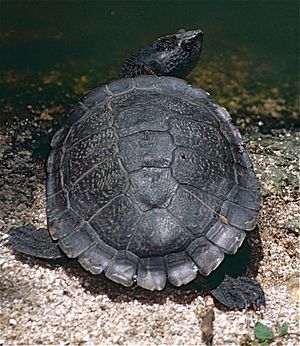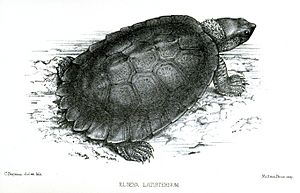Saw-shelled turtle facts for kids
Quick facts for kids Saw-shelled turtle |
|
|---|---|
 |
|
| At a wildlife habitat in Port Douglas, Australia | |
| Scientific classification | |
| Genus: |
Myuchelys
|
| Species: |
latisternum
|
| Synonyms | |
|
|
The saw-shelled turtle, Myuchelys latisternum, is a type of turtle that lives only in Australia. It's part of the Chelidae family. You can find them in rivers, streams, swamps, and lagoons. They live from the Cape York Peninsula down to northern New South Wales. Some people think they were brought to Lake Eacham in the Atherton Tablelands. People also call them the serrated snapping turtle or common sawshell turtle.
Contents
About the Saw-Shelled Turtle
Female saw-shelled turtles are much bigger than males. Their top shell, called a carapace, can be up to 28 cm long. Males usually only grow to about 18 cm. The carapace is mostly oval and wide at the back.
These turtles are not usually aggressive. However, they can bite very hard if they feel threatened. They can also let out a strong, unpleasant smell.
The edges of their shell have jagged, saw-like parts. This is how they got their common name. They keep some of these jagged edges throughout their lives. The shield on their head goes down the side of their head. The top of their neck has pointy bumps.
Their top shell is usually brown or dark brown. It often has some dark spots. The bottom shell, called the plastron, is yellowish. They have a large head with a snout that sticks out. A hard, bony plate covers the top of their head. Their neck can fold sideways. Their feet have webs between the toes and also have claws. Young turtles have jagged back legs, but these become smooth as they get older.
Reproduction and Life Cycle
Saw-shelled turtles become old enough to have babies at different sizes. Males are ready when their shell is about 12.5 to 13.5 cm long. Females are ready when their shell is about 18.2 to 18.9 cm long. They may try to find a mate all year. However, mating is usually seen in mid-January.
You won't find many nests in one spot. Instead, females build their nests alone or in pairs. They spread out their nests along the water's edge. Nests have been found in soil as far as 100 meters from the water.
Females lay their eggs from September to December. They can lay three to four groups of eggs in one season. Each group can have 9 to 20 eggs. The eggs hatch in about 60 days, before winter arrives. In southern areas, the eggs hatch even faster. The eggs are described as either hard-shelled or flexible-shelled. They are about 34 mm long and 22 mm wide. Baby turtles from central Queensland were about 30 mm long. Babies from northern New South Wales were about 32.5 mm long.
What They Eat
The saw-shelled turtle eats many different things. They are omnivores, meaning they eat both plants and animals. But they prefer to eat meat. They eat fish, tadpoles, frogs, and snails. They also eat crabs, dead animals, and insects that live in water or on land.
These turtles are special because they can eat the poisonous cane toad. Cane toads are very dangerous to many other Australian animals. If a cane toad is too big to swallow, the turtle will tear it apart with its front claws. Saw-shelled turtles also eat plants. This includes fruits, leaves, algae, and water weeds.
How They Behave
Like many other turtles that live in water, the saw-shelled turtle can get oxygen from the water. They can do this through their skin, a special part of their body called the cloaca, and their mouth and throat. This allows them to stay underwater for a long time.
Where They Live
You can often find Myuchelys latisternum in the smaller streams or branches of bigger rivers. They live in creeks, waterholes, dams, and lakes. They are very good at adapting to different places. You might see them in woodlands, rainforests, or even on farms. They can also live near towns.
These turtles can be seen resting on logs and rocks near the water. This might be to warm up their bodies in the sun.


